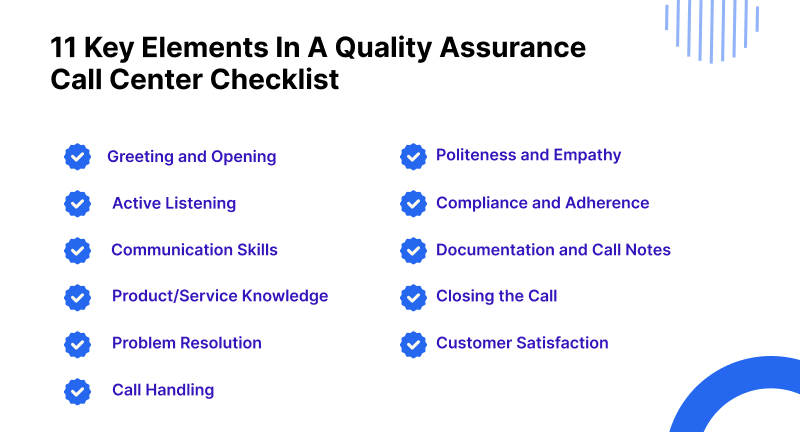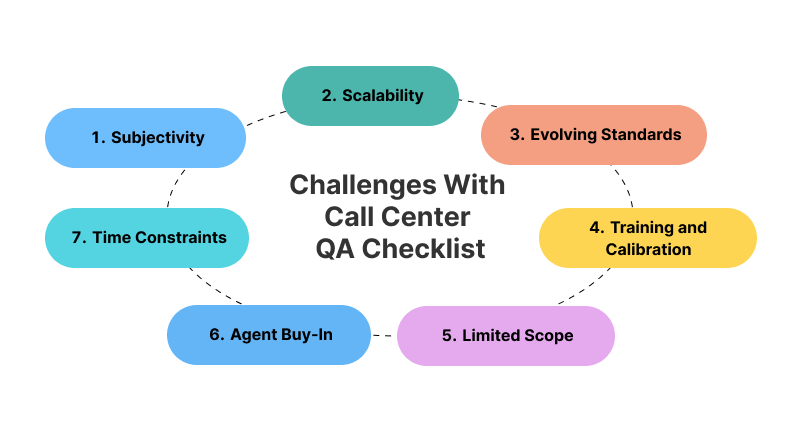In a high‑stakes, customer‑centric environment like a contact centre, delivering consistent, top‑tier service is mission‑critical, and yet small scripting errors, misaligned metrics and inconsistent reviews often chip away at quality and morale. Call centre managers, QA analysts and BPO leaders recognise the need to enforce standards without slowing production.
Building a call center quality assurance scorecard with the right QA checklist is crucial to addressing these challenges and elevating contact centers' performance.
A call centre quality assurance checklist is a structured list of criteria and guidelines used to evaluate and monitor agent interactions and ensure adherence to quality standards and performance metrics.
Ready to move from good to great? Get ahead of the curve with our free QA‑checklist template.
Download our free QA checklist
What Is a Call Center Quality Assurance Checklist?
A customer service quality assurance checklist is a structured document that outlines specific criteria, guidelines, and standards for evaluating agent performance and assessing the quality of client interactions.
This call center qa scorecard is a reference tool for call center managers and QA professionals that ensures consistency, objectivity, and adherence to predefined quality standards.
11 Key Elements in a Call Center Quality Assurance Checklist

A call center quality assurance checklist typically includes the following key elements:
- Greeting and Opening: Assessing how agents initiate the call, greet the customer, and set a positive tone for the interaction.
- Active Listening: Evaluating agents' ability to listen attentively, understand customer needs, and ask relevant questions for clarification.
- Communication Skills: Assessing agents' verbal and written communication abilities, including clarity, professionalism, and the use of appropriate language.
- Product/Service Knowledge: Checking agents' understanding of the call center's products or services, ensuring they can provide accurate and relevant information to customers.
- Problem Resolution: Evaluating agents' problem-solving skills and ability to efficiently and effectively address customer issues.
- Call Handling: Assessing how agents manage the call process, including call flow, call control, and appropriate use of call center tools and systems.
- Politeness and Empathy: Evaluating agents' demeanor, politeness, and empathy towards customers, creating a positive and friendly customer experience.
- Compliance and Adherence: Ensuring agents follow call center protocols, scripts, and any legal or regulatory requirements relevant to the industry.
- Documentation and Call Notes: Assessing agents' ability to accurately document customer interactions, including relevant details, requests, or actions taken during the call.
- Closing the Call: Evaluate how agents conclude the call, summarize key points, offer assistance, and thank the customer for their interaction.
- Customer Satisfaction: Measuring customer satisfaction through post-call surveys, feedback, or other client satisfaction metrics to gauge the overall quality of the customer experience.
Overall, a call center quality assurance checklist for customer service is essential to ensure consistent service delivery, standardize expectations, and evaluate agent performance.
Considering all the key elements mentioned above, a call center QA template can be created.
Get scorecard accuracy via Convin!
This blog is just the start.
Unlock the power of Convin’s AI with a live demo.

Call Center Quality Assurance Best Practices in 2025

Quality Assurance (QA) improves call center quality and ensures excellent customer service.
Here are some practical tips to improve QA in call centers:
1. Define Clear Quality Standards: Establish specific quality standards that align with the organization's goals and customer expectations.
Communicate these standards to all agents and call center QA professionals. This ensures a consistent understanding of performance expectations.
2. Regularly Train and Develop Agents: Invest in comprehensive training programs to equip agents with the necessary skills to meet quality standards.
Regularly assess training needs and provide development opportunities to enhance employee performance to improve customer interactions.
3. Implement Effective Monitoring and Evaluation: Develop a robust call monitoring process to systematically assess reps’ performance.
Utilize call recording and analytics tools to capture client interactions. Evaluate them against predefined quality criteria. Ensure evaluations are fair and consistent; provide actionable feedback to agents.
4. Foster Agent Involvement and Feedback: Involve agents in the contact center QA process by seeking their input and feedback.
Encourage agents to share their insights and suggestions for process improvement. This involvement enhances agent buy-in, improves morale, and creates a collaborative environment for enhancing QA practices.
Convin follows a strong rebuttal management system. Once QA performs the manual auditing, the respective agent accepts the call score or can flag the audit along with the required feedback. The auditor is notified via a detailed email if there are any instances of rebuttals/ disputes.
5. Regularly Review and Update QA Processes: Continuously review and update QA processes to adapt to changing customer expectations, industry standards, and technological advancements.
Assess the effectiveness of the call center audit checklist, evaluation criteria, and performance metrics regularly to ensure they remain relevant and aligned with evolving needs.
6. Promote Knowledge Sharing and Best Practices: Encourage knowledge sharing among call center agents and QA professionals to promote the exchange of best practices.
Create platforms or forums for call center agents to share success stories, challenges, and strategies for delivering exceptional customer service.

7. Leverage Technology: Explore the most appropriate solution, including various technologies, such as speech analytics, quality monitoring software, and customer feedback systems, to streamline QA processes.

Automation can save time, increase efficiency, and provide more accurate evaluations. Below is an example of a contact center QA checklist template.
Nail every post-call analytics with Convin QA!
What are Call Center Quality Assurance Metrics for 2025?

Call center QA metrics are specific measurements used to evaluate the performance, efficiency, and effectiveness of call center operations.
Here are some commonly used metrics, along with examples:
1. First Call Resolution (FCR): Measures the percentage of customer issues or inquiries resolved during the initial call.
Example: FCR is 85%, indicating that 85% of customer issues were resolved without further follow-up.
2. Average Handle Time (AHT): Calculates the average duration of customer calls, including talk time, hold time, and any post-call work.
Example: AHT is 4 minutes, indicating the average time agents spend handling each customer call.
3. Call Abandonment Rate: Indicates the percentage of callers who hang up or abandon their calls before reaching an agent.
Example: The abandonment rate is 10%, meaning 10% of callers disconnect before connecting with an agent.
4. Customer Satisfaction Score (CSAT): Gauges client satisfaction levels through post-call surveys or feedback.
Example: CSAT score is 4.5 out of 5, indicating high client satisfaction with the call center service.
5. Quality Scores: QA teams conduct call center agent evaluation based on predefined criteria and standards.
Example: Agent A receives a quality score of 95%, indicating high adherence to quality standards.
Improve QA alignment with Convin!
Tips and Tools for Customer Service Quality Assurance Checklist

Tips for Call Center Quality Assurance:
- Regular Feedback and Coaching: Based on QA evaluations, provide consistent feedback and coaching to agents. Offer constructive guidance to help them improve their performance and address areas of opportunity.
- Agent Involvement in QA Process: Involve agents in the contact center QA process by encouraging self-assessment and self-monitoring. Empower them to identify areas for improvement and actively participate in their professional development.

- Continuous Training and Development: Offer agents ongoing training and development opportunities to enhance their skills, product knowledge, and customer service techniques. Keep them updated on industry trends and best practices.
Tools for Quality Assurance Checklist
- Call Recording and Monitoring Systems: Utilize call recording and monitoring systems to capture client interactions for evaluation purposes. These tools enable QA professionals to review calls and accurately assess employee performance.
- Quality Management Software: Implement quality management software that streamlines the QA process, automates evaluations, and tracks call center performance metrics. Such tools can generate detailed reports and analytics to identify trends and areas for improvement.
- Speech Analytics: Use speech analytics software to analyze customer speech automatically. These tools can identify keywords, sentiments, and patterns, providing insights into employee performance, client satisfaction, and areas for improvement.
Book your demo today!
Frequently Asked Questions
- What is the importance of QA in a call center?
QA (Quality Assurance) professionals are critical in maintaining and improving customer service standards in a call center.
Their responsibilities include monitoring and evaluating agent performance during client interactions, ensuring compliance with established guidelines and regulations, and measuring key performance indicators.
- What is a QA checklist?
A contact center quality assurance checklist is a structured document that outlines the criteria and processes for evaluating agent performance in a call center.
It includes guidelines for call handling, professionalism, compliance, resolution time, and customer satisfaction.
It ensures consistent assessments, standardizes the evaluation process, and helps identify areas for improvement in customer service.
- What is process checklist in quality assurance?
A process checklist in quality assurance is a tool used to ensure that all required steps and activities are completed correctly and consistently during a particular process or workflow.
It outlines specific tasks, procedures, and quality standards that need to be followed to achieve desired outcomes and maintain quality control.
- What are the key call center QA metrics to track?
QA metrics in a call center are specific measurements used to evaluate the quality and performance of customer interactions and agent behaviors. These metrics provide valuable insights into the call center operations' effectiveness and help identify improvement areas.
Some common call center metrics used in call centers include:
- First Call Resolution (FCR): Measures the percentage of customer issues resolved on the initial call, indicating efficient problem resolution.
- Average Handle Time (AHT): Calculates the average duration of customer calls, providing insights into agent productivity and efficiency.
- Call Abandonment Rate: Indicates the number of callers who hang up before reaching an agent, highlighting potential wait times or call routing issues.
- Customer Satisfaction Score (CSAT): Gauges customer satisfaction levels through post-call surveys, providing valuable feedback on the overall customer experience.
- Quality Scores: Assess agent interactions based on predefined criteria, ensuring adherence to standards and consistent service quality.
- Compliance Rate: Evaluates agent adherence to regulatory requirements, minimizing legal and regulatory risks.
- Call Monitoring Results: Measures the outcomes of call monitoring and evaluations, identifying areas for improvement and maintaining service quality.
- How do you train QA in a call center?
Training QA professionals in a call center involves providing comprehensive materials on policies, standards, and evaluation criteria.
Some of them include:
- Conducting training sessions.
- Demonstrating sample evaluations.
- Fostering calibration sessions.
- Ensure consistent assessment.
- Ongoing coaching and feedback.
- Promoting continuous learning.
- What are the essential QA guidelines call center teams should follow to ensure quality customer service?
QA guidelines call center teams should follow include:
- Set clear communication standards for professionalism and clarity.
- Ensure compliance with regulations and company policies.
- Focus on empathy, active listening, and problem resolution.
- Use metrics like FCR and AHT to assess service quality.
- Provide regular training, coaching, and feedback.
- Monitor calls consistently with predefined criteria.
- Maintain accurate customer interaction records.
These steps ensure consistent, high-quality customer experiences.







.avif)